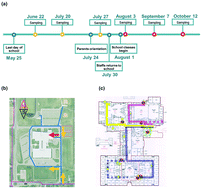Finding building water quality challenges in a 7 year old green school: implications for building design, sampling, and remediation†
Abstract
Water safety was investigated at a school certified as a green building. The study was conducted during low water use (summer break) to normal water use (after break) periods. The copper plumbed building contained water saving devices, a water softener and four hot water recirculation zones, and received chloraminated water from a public water system. Six sampling events at 19 in-building locations (and extra 19 locations for metal analysis) were conducted (June 2018 to October 2018). At the building entry point, 65% of the samples (n = 74/114) had no detectable disinfectant residue, heterotrophic plate count ranged from 11 to 400 CFU/100 mL, and no copper action level (AL) exceedances were found; the AL is a health-based threshold. Inside the building, almost 70% of first draw cold samples exceeded the AL during summer, while 37% of samples exceeded the AL after classes resumed. Total copper concentration in the building was related to the distance from the building entry point. The softener was an incubator for bacterial growth and nitrification was detected throughout the plumbing (n = 29/29 for hot, n = 17/22 for cold). The state's recommended spot flushing remediation strategy for reducing copper concentration was ineffective. Water chemical and microbiological testing is recommended before new schools are placed into service and during the life of new and existing buildings. Building water system design standards lack explicit consideration of source water quality, plumbing operation, and material-water compatibility. School plumbing was designed and operated in a way that presented a risk to the health of its occupants.



 Please wait while we load your content...
Please wait while we load your content...
